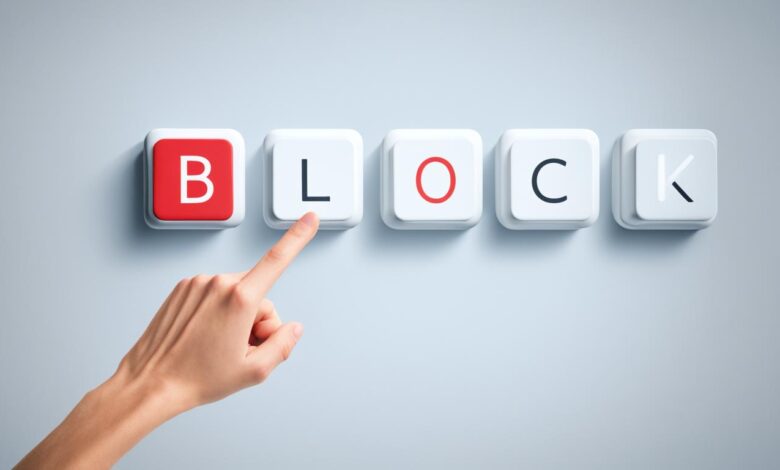Block Button: Control Your Online Experience

The block button empowers users to manage their online interactions. It allows people to remove unwanted connections and content. This tool helps create a safer, more enjoyable digital experience.
With the block button, users can set boundaries for their online presence. It gives them control over who can interact with them. We’ll explore its importance and how to use it effectively.
Key Takeaways
- The block button is a crucial feature for controlling online interactions and maintaining a positive digital experience.
- Blocking enables users to set personal boundaries and protect their mental well-being in digital spaces.
- Understanding the power and proper use of the block button can help mitigate online harassment and safeguard personal information.
- Blocking is an effective tool for enhancing productivity and avoiding unwanted content or interactions in the workplace.
- Utilizing the block button is an act of self-care that can significantly improve one’s overall online experience.
The Power of the Block Button
Social media is now a big part of our lives. Setting online boundaries is key for digital wellbeing and social media self-care. The block button can change our online experience and build a healthy internet ecosystem.
About 88% of young Americans use social media often. This has created a need to control online boundaries and set limits. Staying connected with unwanted contacts can cause emotional distress.
Experts suggest blocking ex-partners on social media. This helps reduce the urge to seek information and aids healing. Many users report better mental health after blocking others online.
“The block button is a powerful tool for maintaining a healthy balance between digital interactions and personal well-being.”
Using the block button is crucial for building a healthy internet ecosystem. People who choose their online contacts feel more empowered. They have better control over their digital space.
The block button helps manage digital interactions effectively. Setting limits and controlling our online boundaries impacts our digital wellbeing. It can greatly improve our overall happiness.
Misconceptions About Blocking
Blocking on social media isn’t mean or hurtful. It’s a gentle way to prioritize well-being and peace. Think about how you feel and if blocking would improve your online experience.
Blocking isn’t a sign of weakness. It shows self-awareness and commitment to mental health. It’s a powerful tool for online conflict resolution and social media etiquette.
Blocking doesn’t always sever ties forever. Sometimes, unblocking can lead to closure or personal growth. Communicate openly and align decisions with your blocking etiquette and setting healthy boundaries.
“Blocking is not about punishing someone or winning an argument. It’s about prioritizing your own well-being and creating a more positive online environment.”
Blocking is a personal choice requiring thoughtfulness. By challenging misconceptions, you can take control of your online experience. This helps create a healthier, more fulfilling digital life.
Blocking doesn’t reflect your strength or relationships. It’s a tool for navigating online interactions and maintaining social media etiquette. With the right approach, blocking becomes an act of self-care and online conflict resolution.
The Difference Between Online and Real Life
Online and real-life interactions are different. The internet is part of our daily life, but we can step away from it. We can close our devices and reconnect with the physical world. Taking digital detox breaks can help clear the mind.
Stepping away from the virtual realm can provide perspective on online issues. It helps us realize how trivial some online conflicts may be. Blocking someone online can feel less important in our overall life.
This separation between online and offline experiences is key to well-being. It’s an important aspect of social media breaks and maintaining a healthy work-life balance.
Separating Virtual Interactions from Physical Reality
Responding with kindness can disarm or escalate anger in retail situations. Positive responses to toxic behavior may deter future negative actions. This applies both online and in real life.
Immediate blocking is common online but doesn’t build conflict resolution skills. It’s like avoiding interactions by wearing headphones in public. Learning to handle difficult people can increase success in various life aspects.
| Platform | Block Feature |
|---|---|
| Facebook, Twitter, Instagram | Straightforward blocking capabilities |
| Square Cash | Past issue with abusive payments due to included messaging |
| Slack | No option to block specific individuals from sending direct messages |
| Spotify | Challenges in preventing others from following user activity |
| Etsy | No “block buyer” option, impacting both buyers and sellers |
Balancing online and offline lives is crucial in the digital age. Regular social media breaks help gain perspective. They ensure virtual interactions don’t overshadow our physical reality.
Graceful Blocking Techniques
Online blocking needs careful thought and good manners. The block button helps set limits, but use it wisely. It’s a tool for keeping chats healthy and safe.
Tell people why you’re blocking them, especially friends or family. This can ease future meetings. Be honest but kind when explaining your reasons. Set a clear boundary while showing respect.
Think about your ties to the person before blocking. Sometimes, a message isn’t needed if bad behavior keeps happening. For closer relationships, an explanation can help keep understanding.
Graceful blocking considers the situation and your bond with others. It aims for healthy online communication and sets boundaries with care. Balance being firm and kind to protect yourself and your relationships.

“Graceful blocking is about finding the right balance between setting clear boundaries and maintaining respect.”
block button: A Powerful Tool for Online Safety
The block button is crucial for online safety and digital security. It empowers users to control their online experiences. This feature shields users from cyberbullying and unwanted interactions.
Blocking is the “first line of defense” against social media harassment. Teens prefer blocking over reporting concerning behavior. This highlights the importance of accessible blocking options.
Many platforms require apps to offer robust blocking capabilities. Failure to do so can result in removal from app stores. This underscores the critical role of the block button.
“Blocking serves as a crucial tool to set boundaries in the digital world, similar to how we establish limits in real life.”
Recent developments, like removing the block feature on X, raise concerns. This could impact protecting users from abusive behaviors. It may disproportionately affect marginalized communities, who are often more vulnerable.
Blocking mitigates unwanted solicitations like spam and scams. It also safeguards against serious threats, including stalking and harassment. The block button empowers individuals to prioritize their online safety.
The importance of the block button for online protection is undeniable. Strengthening blocking features can enhance the overall online safety ecosystem. Implementing solutions to prevent circumvention can further improve digital security.
Blocking vs. Muting: Understanding the Differences
Social media users need tools to manage their online interactions. Muting someone allows them to still follow you and see your posts. However, blocking completely removes their ability to interact with you or see your content.
Blocking is the only way to truly limit contact from unwanted individuals. It prevents the blocked person from seeing your profile or searching for you. Blocking also removes access to shared libraries.
iNaturalist introduced blocking in 2016, eight years after its launch. This feature aims to prevent re-traumatization by someone who has threatened or caused harm in the past.
| Muting | Blocking |
|---|---|
| Removes the user’s Watched, Watchlisted, or Rated activities from your feed without them knowing they have been muted. | Unfriends the user and prevents them from seeing your profile content or searching for you. |
| Prevents the muted user from showing up in friend suggestions. | Removes access to shared libraries. |
| Muting cannot be done to individual activity types, it is a general action. | Users can block up to three other accounts on iNaturalist for any reason. |
Muting can help manage online interactions. However, blocking is the most effective way to ensure a safe social media experience. It completely removes an unwanted individual’s ability to engage with you or see your content.
“Blocking is the only way to truly limit all forms of contact from an unwanted individual and ensure a safe, uninterrupted online experience.”

Implementing Blocking on Various Platforms
Controlling our online experiences is vital in today’s digital world. The block feature helps users maintain a secure online presence. We’ll explore how to implement blocking on different devices and systems.
Blocking on Social Media Platforms
Social media platforms offer robust blocking features for managing online interactions. These tools help users control their digital environment effectively.
Let’s look at the blocking capabilities of popular social media apps:
- Instagram: Users can hide comments by blocking specific individuals. The platform allows filtering offensive comments and specific words. The “Restrict” feature protects from unwanted interactions without fully blocking.
- Twitter: Users can filter sensitive content and apply content warnings. They can mute or block individuals to manage visibility and interaction.
- Facebook: Users can unfriend or unfollow to manage newsfeed content. Blocking restricts profile visibility and interaction.
The block feature is crucial for a secure online experience. It empowers users to control their digital spaces effectively.
Blocking at the Browser and Device Level
Users can use browser-based and device-level controls to enhance online safety. Browser extensions like BlockSite for Chrome block specific websites and domains.
Device-level parental controls and Wi-Fi router settings can restrict access to certain websites. This provides a comprehensive approach to digital hygiene.
Understanding these blocking techniques helps users create a positive digital environment. They can tailor their online experiences to match their preferences and safety needs.
The Role of Secure Browsers
The digital age brings online threats. Your choice of web browser can boost privacy-focused browsers and online security. Secure browsers, like Avast Secure Browser, offer strong protection for your digital life.
Privacy-focused browsers often have built-in ad-blocking features. These stop unwanted pop-ups and speed up website loading. This improves your browsing and helps with minimizing digital distractions.
Secure browsers let users control their digital space. You can block specific websites or content types. This customization allows you to tailor your online interactions.
You can create a more personal and secure browsing experience. This puts you in charge of your online activities.
| Feature | Benefit |
|---|---|
| Ad-blocking | Improves website load times and reduces distractions |
| Website blocking | Enhances control over online content and privacy |
| Sandboxing and hardening | Strengthens security by isolating web browser from system |
Secure browsers use advanced security measures like sandboxing and hardening. These protect users from web-based vulnerabilities. They isolate the browser from the operating system.
This isolation helps shield the entire system from potential threats. It adds an extra layer of protection to your online activities.
Using privacy-focused browsers is key for a secure online presence. It helps you control your online security and manage digital distractions. Take charge of your digital life with these powerful tools.
Balancing Safety and Accessibility
Online safety requires a balance between user empowerment and universal access. Inclusive design and accessibility considerations are crucial in our digital landscape.
The block button empowers users to control their online experiences. It helps avoid harmful content and interactions. Childnet stresses its importance for young people’s digital well-being.
Universal access is equally vital. Removing the blocking feature could compromise safe navigation for all users.
“The block button is a powerful tool for maintaining online safety, but it must be balanced with accessibility concerns to ensure empowering users and promoting inclusive design.”
We can create a digital ecosystem that empowers individuals and prioritizes accessibility. This means keeping the block button while exploring innovative inclusive design solutions.
We must remain vigilant and adaptable in this process. Seeking feedback from diverse user communities is essential. Their perspectives will help create a truly inclusive and accessible digital world.
Responsible Blocking Practices
Ethical blocking online requires careful thought. It involves weighing situational factors and online behavior norms. The block button is powerful, but its use demands a thoughtful approach.
Blocking isn’t always the answer. Sometimes, unblocking can lead to closure and better relationships. It’s important to consider context and consequences when making these decisions.
Navigating the Ethics of Blocking
Responsible blocking practices require ethical thinking and a safe digital space. This means balancing personal boundaries with potential for growth and reconciliation.
- Assess the context: Consider the situation, interactions, and impact of blocking on everyone involved.
- Explore alternatives: Try open communication, setting boundaries, or seeking mediation before blocking.
- Prioritize empathy: Understand that people have different perspectives shaping their online behavior.
- Revisit decisions: Review blocks periodically. Be open to unblocking if situations change or reconciliation is possible.
A nuanced decision-making process and ethical blocking practices can create a better digital landscape. This approach allows for confident and respectful online experiences.
| Scenario | Considerations for Blocking | Potential Alternatives |
|---|---|---|
| Repeated harassment or abuse | Blocking may be necessary to protect one’s well-being and set clear boundaries. | Reporting the behavior, seeking support from platform moderators, or exploring legal options. |
| Difference of opinion or conflict | Evaluate the severity and potential for escalation before deciding on blocking. | Engaging in respectful dialogue, setting personal boundaries, or seeking mediation. |
| Potential for reconciliation | Consider unblocking if the individual has shown growth or remorse, and there is an opportunity for a healthier relationship. | Open communication, setting clear expectations, and working towards mutual understanding. |
A nuanced and ethical approach to blocking fosters a more inclusive digital landscape. It allows for confident and respectful online experiences.
Conclusion
The block button empowers users to control their online experiences. It helps create a safer, more enjoyable digital environment. Users can manage interactions and prioritize well-being by understanding blocking practices across platforms.
We’ve explored setting boundaries and navigating virtual interactions. The block button is crucial for safeguarding online spaces. It fosters a healthier, more inclusive internet ecosystem.
The block button is a valuable asset in our digital lives. Using it responsibly shapes a more empowering online experience. It allows us to take control of our digital environments.
This feature paves the way for a positive internet experience. It stands as a testament to our ability to prioritize well-being. Embracing the block button contributes to a more enriching online world.
FAQ
What is the purpose of the block button?
The block button helps users manage their online interactions. It lets people remove unwanted connections and content. Users can set boundaries and control their online presence with this tool.
How can the block button make a difference in one’s life?
The block button can greatly impact daily life and happiness. It helps create a safe space for healing. This is especially useful when someone from the past reappears online.
Is blocking someone a mean or hurtful act?
Blocking isn’t mean or hurtful. It can be done gently and respectfully. The focus is on protecting your well-being and peace of mind.
How do online and real-life interactions differ?
Online and real-life interactions are different. We can step away from digital platforms and reconnect with the physical world. Taking breaks from social media can help clear your mind.
It provides perspective on the importance of online conflicts.
Should I send a message when blocking someone?
Sending a message when blocking can be helpful. It’s not required, but it may ease future in-person interactions. Be honest and direct without being cruel.
When is blocking necessary for online safety?
Blocking is crucial when dealing with harassment or threats. You have the right to block anyone who makes you uncomfortable. If real-life threats occur, consider legal protection and seek support.
What is the difference between muting and blocking someone?
Muting someone doesn’t provide the same control as blocking. When muted, they can still follow you and send messages. Blocking removes their ability to interact with you completely.
How can I block websites on my browser?
Use website blocker extensions like BlockSite to block websites on Chrome. Enter the URLs you want to block. You can also use parental controls or block sites through Wi-Fi router settings.
How can secure browsers help with online safety?
Secure browsers, like Avast Secure Browser, enhance online safety. They often have built-in ad-blocking features. These browsers may offer options to block specific websites or content categories.
Is there a need to balance safety and accessibility when using the block button?
Balancing safety and accessibility is important when using the block button. Childnet stresses that blocking should remain an option for users. Removing this feature could affect users’ ability to manage their online environments.
Are there situations where unblocking someone may be appropriate?
Unblocking may be appropriate in some situations. If there’s room for growth, it could lead to closure. Consider the context and potential consequences when deciding to unblock someone.




